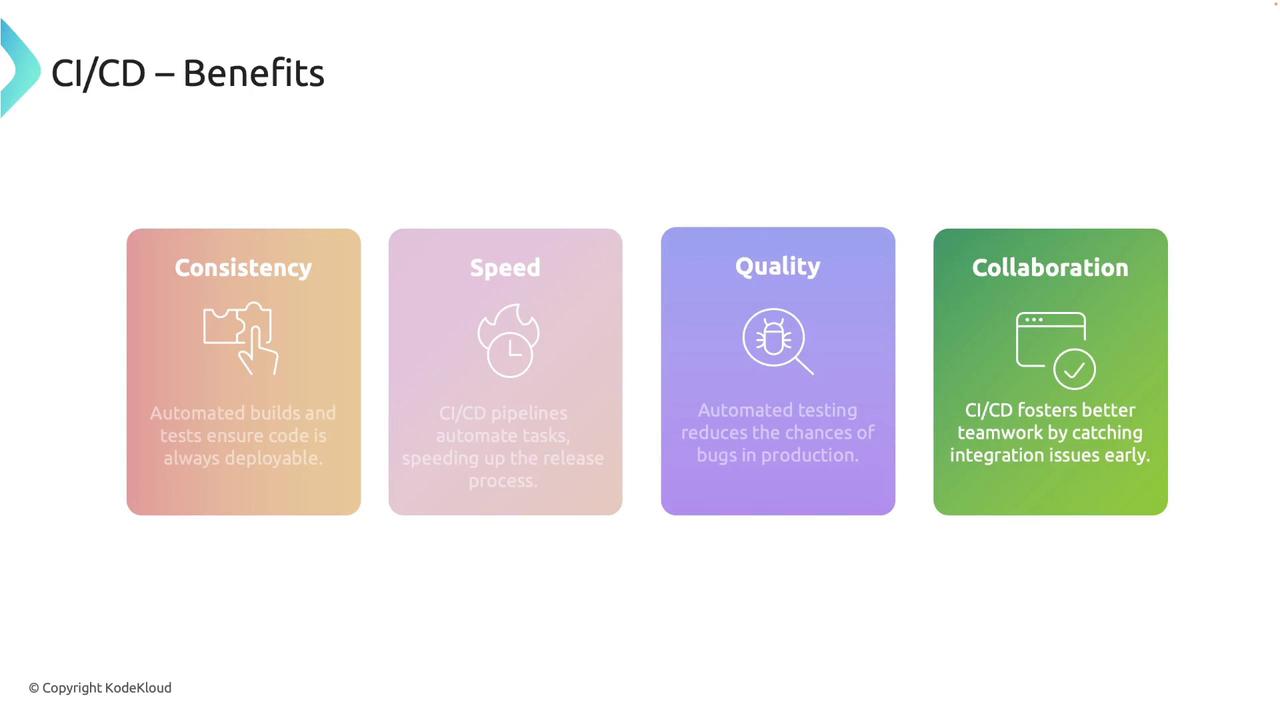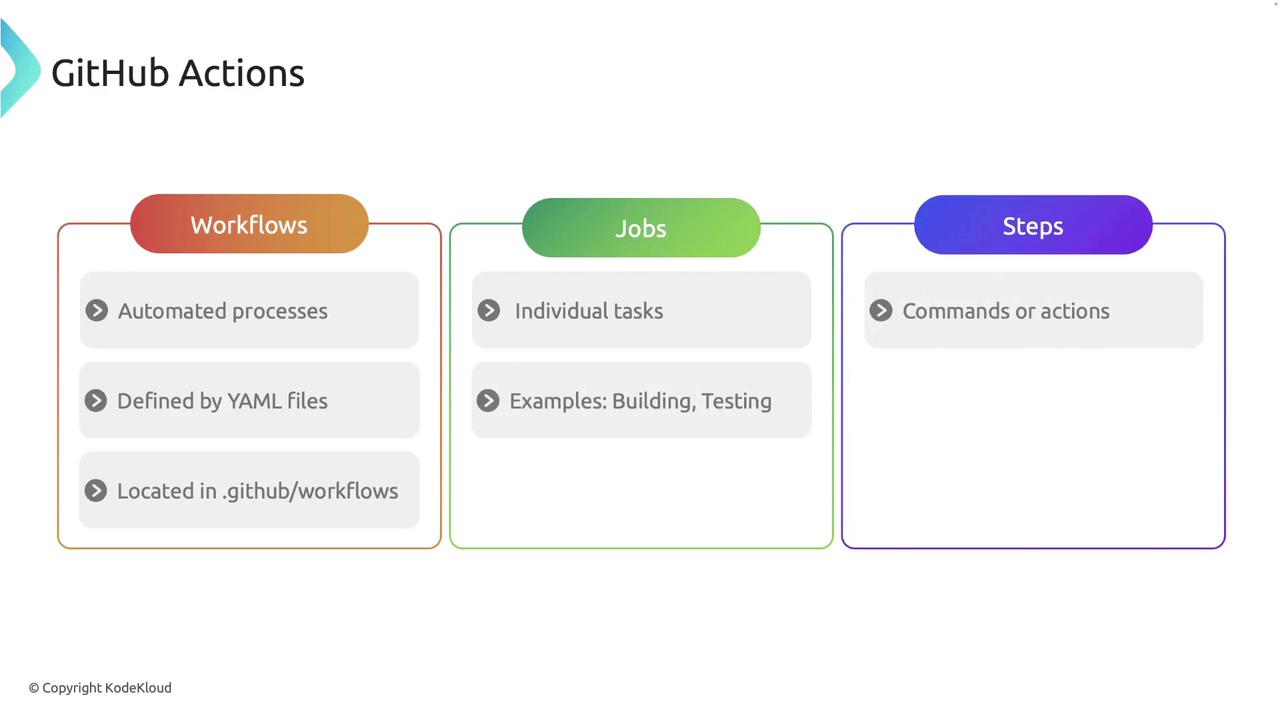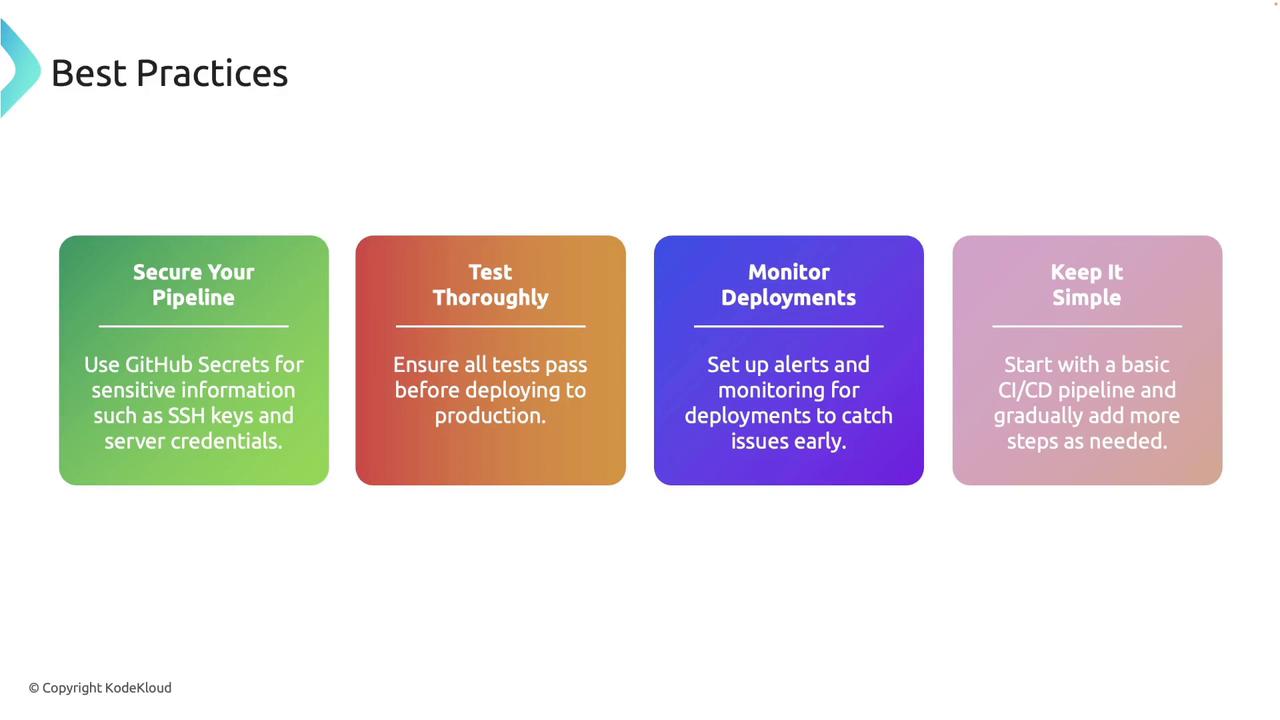Rust Programming
Testing Continuous Integration
Building and Deploying with CICD
In this lesson, we’ll show you how to set up a continuous integration and continuous deployment (CI/CD) pipeline specifically tailored for Rust projects. You will learn how to automate the building and testing of Rust applications using GitHub Actions, understand the importance of CI/CD pipelines, and implement them to ensure robust and reliable code deployment.

Introduction to CI/CD
Continuous integration and continuous deployment are essential practices in modern software development. CI ensures that every code change is automatically built and tested, while CD automates the deployment process to production. Key benefits include:
- Consistency: Automated builds and tests ensure that your codebase is always deployable.
- Speed: Pipelines accelerate the release process by automating repetitive tasks.
- Quality: Automated tests catch issues early, reducing the likelihood of bugs reaching production.
- Collaboration: CI/CD helps identify integration issues promptly, encouraging a coordinated development environment.

Overview of GitHub Actions
GitHub Actions is an integrated CI/CD platform within GitHub that simplifies the automation of software workflows. With GitHub Actions, you can run tests, build your Rust projects, and deploy applications—all directly from your repository. Key components include:
- Workflows: Automated processes defined using YAML files, located in the
.github/workflowsdirectory. - Jobs: Individual tasks within a workflow, such as building or testing the project.
- Steps: The specific commands or actions that make up a job.

Setting Up a Basic CI Workflow
Follow these steps to create a simple CI workflow for your Rust project.
1. Initialize Your Git Repository
Start by creating a new GitHub repository or using an existing one. Initialize the repository and add the remote origin with the following commands:
git init
# (Output: Reinitialized existing Git repository in /path/to/repository/.git/)
git remote add origin https://github.com/Priyanka488/rust_mock.git
2. Create the Workflows Directory
Set up the directory structure required for GitHub Actions:
mkdir -p .github/workflows
3. Define the Workflow File
Within the .github/workflows folder, create a file named ci.yaml and add the following configuration:
name: Rust CI
on: [push, pull_request]
jobs:
build:
runs-on: ubuntu-latest
steps:
- name: Checkout code
uses: actions/checkout@v2
- name: Set up Rust
uses: actions-rs/toolchain@v1
with:
toolchain: stable
override: true
- name: Build
run: cargo build --verbose
- name: Run tests
run: cargo test --verbose
In this workflow:
- The pipeline is triggered on every push or pull request.
- Jobs run on the latest Ubuntu environment.
- Steps include checking out the code, setting up Rust, building the project, and running tests.
4. Commit and Push Your Workflow
After setting up your workflow, stage your changes, commit, and push to your main branch:
git add .
git commit -m "Initial commit: add CI workflow"
git push origin master
Visit your repository’s GitHub Actions tab to monitor the workflow run. You should see that each step—checkout, build, and test—executes successfully.
Enhancing the Workflow with Linting and Formatting
For improved code quality, extend your CI workflow to include linting and formatting checks using Clippy and Rustfmt. Update your ci.yaml file as shown below:
name: Rust CI
on: [push, pull_request]
jobs:
build:
runs-on: ubuntu-latest
steps:
- name: Checkout code
uses: actions/checkout@v2
- name: Set up Rust
uses: actions-rs/toolchain@v1
with:
toolchain: stable
override: true
- name: Install Clippy
run: rustup component add clippy
- name: Run Clippy
run: cargo clippy
- name: Build
run: cargo build --verbose
- name: Run tests
run: cargo test --verbose
- name: Run Rustfmt
run: cargo fmt -- --check
After configuring these additional steps:
- Clippy is installed to identify common issues.
- The project is built and tested.
- Rustfmt checks ensure that your code adheres to standard formatting guidelines.
Stage, commit, and push your changes:
git add .
git commit -m "Add linting and formatting checks"
git push origin master
Then, observe the updated workflow in the GitHub Actions tab to verify that linting and formatting checks execute correctly.
Best Practices for CI/CD Pipelines
Adopt the following best practices to maintain a robust CI/CD pipeline:
- Secure Your Pipeline: Use GitHub Secrets to manage sensitive information, such as SSH keys and credentials.
- Ensure Test Coverage: Always ensure that your tests pass before deploying to production.
- Monitor Deployments: Keep a close watch on deployments to quickly identify and resolve potential issues.
- Start Simple: Begin with a basic pipeline and incrementally add steps as your project evolves.

Note
Following these best practices not only improves the reliability of your deployments but also enhances overall code quality and team collaboration.
Watch Video
Watch video content
Practice Lab
Practice lab